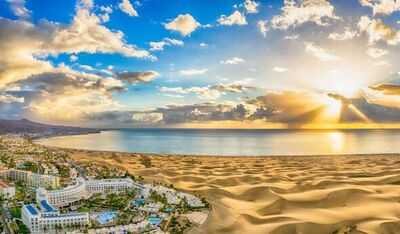
A growing social media trend along the Maspalomas seafront in Gran Canaria is damaging the coastline and endangering local wildlife, environmental experts have warned. The popular fad involves tourists stacking stones into small towers on the popular Canary Islands beach, with the aim of snapping them for TikTok and other platforms.
However, researchers have warned that this activity could have lasting negative effects. "Removing stones from their natural position weakens the coastal barrier that protects everything behind it," explains Abel Sanromualdo, a researcher at the Institute of Oceanography and Global Change at the University of Las Palmas de Gran Canaria (ULPGC). "Those rocks help absorb wave energy. When they're taken away, erosion increases and waves can reach further inland." While moving just a few stones might seem harmless, Mr Sanromualdo cautioned that repeated activity over time gradually undermines the beach's natural defences, especially during strong southwesterly storms that often hit the area.
However, erosion is not the only concern, as the moving of these stones also affects the local wildlife.
"Those stones are habitats for small animals such as insects, crabs, and lizards," added Mr Sanromualdo. "By moving them, we remove their shelter and expose them to predators. Many of these species can't adapt if their environment changes suddenly."
He also notes that the practice also disrupts the geological record of the area: "These stones were placed there naturally by the sea over time; they're part of the island's history. When we rearrange them, we lose valuable information that could help future studies on coastal change".

Experts are urging greater public awareness and education to curb the trend. Simply removing the stone piles, Mr Sanromualdo argued, "won't solve the problem unless people understand why it's harmful".
Maspalomas Beach (Playa de Maspalomas) is situated on the southern part of Gran Canaria and spans 400 hectares. Its magnificent golden sand dunes are one of the main draws of the beach. The waters are relatively calm, making it an ideal beach destination for holidaymakers seeking to swim. The climate also means that the waters are warm throughout the year.
The tourist resort of the same name sits just next door, stretching from Bahía Feliz in the east to Meloneras in the west, including the resort towns of San Agustín, Playa del Inglés and Campo de Golf. The seafront at Punta de Maspalomas, the southernmost point of the resort, is dominated by a 184-foot-tall lighthouse, El Faro de Maspalomas, which overlooks the 7.5-mile-long beach. Completed in 1890, it was built to guide ships travelling between Europe and the Americas.
You may also like

Gujarat BJP chief Vishwakarma pledges support to farmers in Surendranagar

5 dead, 14 injured as passenger train collides with goods train in Chhattisgarh's Bilaspur

Southport killer's brother reveals chilling moment he feared Axel Rudakubanu 'will kill'

HP High Court issues notice to state govt on PIL against extension of Shimla mayor's tenure

"TMC protecting infiltrators": Suvendu Adhikari slams Mamata Banerjee over protest announcement on SIR







